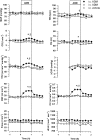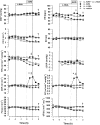Direct coronary vasodilator action of adrenomedullin is mediated by nitric oxide
- PMID: 14623767
- PMCID: PMC1574158
- DOI: 10.1038/sj.bjp.0705572
Direct coronary vasodilator action of adrenomedullin is mediated by nitric oxide
Abstract
Increased circulating levels of adrenomedullin (ADM) cause peripheral vasodilatation and hypotension, accompanied by cardiac actions including tachycardia and increases in cardiac contractility, cardiac output, coronary conductance (CC) and coronary blood flow (CBF). It is unclear to what extent these cardiac effects are direct actions of ADM or secondary to the hypotension and altered cardiac loading. The direct cardiac actions of ADM were examined in conscious sheep previously implanted with aortic and coronary flow probes, and an indwelling left coronary artery cannula. Responses to infusion of ADM (0.5 microg kg(-1) h(-1) for 1 h) into the left coronary artery or jugular vein were compared (n=6). The effect of blockade of nitric oxide (NO) synthase with intracoronary (i.c.) N(omega)-nitro-l-arginine (l-NNA; 1.5 mg kg(-1) h(-1), infused for 2 h before and during ADM infusion, was assessed to determine whether the responses to ADM were mediated by NO (n=5). I.c. ADM caused large and sustained increases in CC (0.35+/-0.07-0.55+/-0.13 ml min(-1) mmHg-1, P<0.05) and CBF (28+/-6-42+/-9 ml min(-1), P<0.05), but had no effect on arterial pressure or indices of cardiac contractility (first differential of the upstroke of systole and peak aortic flow rate). Intravenous infusion of ADM had no effects. I.c. l-NNA, at a dose that abolished the coronary vasodilator action of acetylcholine, blocked ADM-induced coronary vasodilatation. In conclusion, ADM had a direct coronary vasodilator action that was mediated by release of endogenous NO and resulted in increased CBF. There was no evidence for a direct inotropic action of ADM.
Figures


References
-
- BEDNARIK J.A., MAY C.N. Evaluation of a transit-time system for the chronic measurement of blood flow in conscious sheep. J. Appl. Physiol. 1995;78:524–530. - PubMed
-
- FENG C., KANG B., KAYE A., KADOWITZ P., NOSSAMAN B. L-NAME modulates responses to adrenomedullin in the hindquarters vascular bed of the rat. Life Sci. 1994;55:PL433–PL438. - PubMed
-
- HORIO T., NISHIKIMI T., YOSHIHARA F., NAGAYA N., MATSUO H., TAKISHITA S., KANGAWA K. Production and secretion of adrenomedullin in cultured rat cardiac myocytes and nonmyocytes: stimulation by interleukin-1beta and tumor necrosis factor-alpha. Endocrinology. 1998;139:4576–4580. - PubMed
-
- IHARA T., IKEDA U., TATE Y., ISHIBASHI S., SHIMADA K. Positive inotropic effects of adrenomedullin on rat papillary muscle. Eur. J. Pharmacol. 2000;390:167–172. - PubMed
-
- IKENOUCHI H., KANGAWA K., MATSUO H., HIRATA Y. Negative inotropic effect of adrenomedullin in isolated adult rabbit cardiac ventricular myocytes. Circulation. 1997;95:2318–2324. - PubMed
Publication types
MeSH terms
Substances
LinkOut - more resources
Full Text Sources
Miscellaneous

